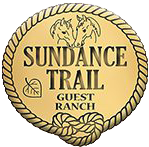Junior Rider Badge
Our purpose in providing this program is:
- Provide girls an opportunity to explore and learn about Western Horsemanship.
- Provide girls an opportunity to learn and build fun memories with their parents and their troop.
- Provide a safe riding experience.
- Get girls addicted to horses and horse back riding, so that they will come back and work for us when they are old enough. (Ooops! We’re not supposed to tell you that!)Within the bounds of safety, all of these requirements are flexible, and can be adjusted to meet the needs of an individual or troop (i.e. “Moms rule”). If you have Brownies or Cadets, please feel free to call us, and we can work with you to structure an appropriate learning experience.
Item Do before you come to Sundance Trail Ranch Bring with you to Sundance Trail Ranch What we will do at Sundance Trail Ranch 1. Get Ready to Ride:
1.1 Saddle and bridle a horse by yourself.
1.2. Explain the care and use of each part of the tack and the importance of correct fitting.
1.3.Hitch a horse at the correct height when bridled, using a halter, a suitable knot, and the correct length of lead rope.
We will teach you here. We will teach you here. We will teach you here. 2. Equipment Expert2.1. Visit a harness or tack shop or obtain a harness catalog and become acquainted with different styles of saddles, bridles, and bits.
2.2. Find out the advantages of each type and know the approximate cost of each type.2.3. Teach someone else how to clean and care for tack.Make notes about English, Western., Australian, Make notes about English, Western., Australian, est: English, Western., Australian, 3. In good form:3.1. Show that you can do the following:
Mount and dismount correctly
Turn and stop a horse, at both a walk and a trot, and on command.
N/A N/A We will teach you. Except we do not trot on first ride. 4. Clips4.1. Examine the tools used to groom a horse.
4.2. Discover the purpose of each.
4.3. Learn to use the brush and currycomb.
4.4. Learn how to brush a horse before and after saddling.
4.5 Practice safe stall and barn behavior.
Investigate: What is safe barn behavior? Make a list: What is safe barn behavior? We will teach you. 5. Ride On5.1. Plan and take part in a ride with others that includes a trail breakfast or other meal, group skill riding, or a cross-country ride. N/A N/A We will do short cross-country ride. 6. Horses, Safety, and You: 6.1. Explain to your troop, friends, or family the safety regulations for riding, and equestrian etiquette.
6.2. Show how to give proper hand signals when riding on public roads and how to do an emergency dismount at halt and at walk.
6.3.Tell what to do if your horse rears, trips, bucks, stops, or bolts.What are these? Make a list. Bring with you. You will be tested. 7. Horse Anatomy:7.1. Name the principal parts of a horse.
7.2 Find out from a veterinarian or horse trainer what can be done to prevent the common ailments or diseases of horses.
Learn this. Make a drawing and label parts. You will be tested. 8. Identify two new riding skills you want to learn. Then work with an instructor to learn and practice. 9. Perfect Your Form.9.1. Take riding lessons to learn the basics of riding:
lead a horse before and after riding,
mount and dismount,
start,
stop and
back up,
ride at a walk and
trot, and
guide a horse while riding and with supervision.9.2. Already know the basics? Then demonstrate to others how to
mount and dismount, and
ride at a walk and a trot.
Show others how to groom a horse and
how to care for a horse after exercising.We will do this here (except trot). 10, See for Yourself:10.1 Take a trip to a state or county fair to see a horse show.
If possible, enter a show class that is right for you and your horse.
The Test. Ohmygosh! You are going to show us the test? Yup! We want you to learn from this!
1. Horses are prey animals. This means:
□ They pray a lot. They are very religious, but don’t spell too good.
□ Predators eat them.
2. Horses are:
□ Big & brave and fight predators.
□ Are like bicycles – they always do what you tell them to do.
□ Big bunny rabbits.
3. Horses have:
□ Very good vision (they can see well).
□ Very poor vision (they do not see well).
4. When a horse sees a “dragon” she will:
□ Spook.
□ Say hello.
□ Smell it.
5. Horses:
□ Never kick or bite each other.
□ Often kick or bite each other.
6. Colic is a:
□ Stomach ache.
□ Bad mood.
7. Founder is:
□ Serious! Horses can die of founder.
□ Not serious.
8. The most common cause of founder is:
□ Getting into the feed room and pigging out.
□ Walking on hard rocks.
9. Why brush your horse before saddling?
10. What are Stirrups
11. What are Reins
12. What is safe barn behavior?
13. What do the following words mean?
To rear:
To trip:
To buck:
To bolt:
To spook:
To Jog or Trot:
To lope or canter:
Withers:
